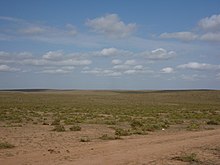Sarai (city)
Sarai (also Saraj , Sarāy al-maḥrūs - "god-protected house", old Sarai , Sarai-Batu ; derived from the Persian سرای sarây "house", "residence") was a medieval city, the capital of the Golden Horde and one of the largest Cities of Eurasia in the Middle Ages.
Old Sarai
Alt-Sarai was around 1242 by Batu Khan after his return from the Battle of Mohi founded and was located on the Akhtuba , a tributary of the Volga River , about 120 kilometers upstream from today's Astrakhan in the area of the village Selitrennoje in Rajon Kharabali . Its population is estimated at up to 600,000, the area of the city, which stretched 10 kilometers along the river, was 36 square kilometers. Its inhabitants included Mongols, Kyptschaks , Alans , Circassians , Russians and Bulgarians, but also Byzantines and Italians. After the subjugation of the principality of Vladimir-Suzdal by the armies of Batu Khan in 1238, its rulers had to travel to Sarai to receive the title of prince from the Khan of the Golden Horde.

Saraj-Batu was the economic and trading center of the Golden Horde and was located on the Silk Road . Each people lived in their own neighborhood. In the respective neighborhood there was everything necessary for life - school, church, bazaar, cemetery. In addition to the separation according to nationalities, there was a breakdown according to occupations - the blacksmith, jeweler, glassblower, metalworking district. The majority of the buildings were made of bricks. The city had a sewer system and a water supply.
In 1261 an eparchy was established in Saraj-Batu .
New Sarai
At the latest under Jani Beg (around 1342) the capital was moved 180 km upstream to New Sarai (Saray al-Jadidah) near today's Kolobowka (formerly Tsarev). This city, which according to Frähn first appeared on coins in 1310, was probably expanded into the capital under Uzbek Khan in the 1330s. Another term is Berke-Sarai. It is not clear, however, whether this is to be equated with new or old sarai.
In 1366 Old Sarai was plundered and burned down by the Russian Ushkuiniki , in 1395 New Sarai by Timur . Both cities only disappeared from the coins in the 15th century.
archeology
In the course of decades of excavations in Sarai-Batu, archaeological layers from the 14th to 15th centuries were discovered. Discovered in the 18th century, but not from the 13th century. There is a version by AW Pachkalov, according to which the city of Sarai was first located in the area of today's village of Krasny Yar - where finds from the 13th century were made - and was only moved to the area of today's village of Selitrennoye around 1330.
Remarks
- ↑ Cf. CM von Frähn: The coins of the Chane from Ulus Dschutschis , p. 44
- ↑ See Janet Martin: Medieval Russia 980–1584 , p. 157
literature
- Пачкалов А. В. О местоположении Сарая (первой столицы Золотой Орды) // Археологія та етнологія Східної Європи. Матеріали і дослідження. Т. III. Одеса, 2002. С. 177;
- Пачкалов А. В. Монетные дворы Золотой Орды и их локализация // Archivum Eurasiae Medii Aevi. Vol. XIII. Wiesbaden, 2004. С. 131-183;
- Пачкалов А. В. Трансгрессия Каспийского моря и история золотоордынских городов в Северном Прикаспии // Восталд. Вып. 8. Казань, 2007. С. 171-180;
- Пачкалов А. В. Красноярское городище в дельте Волги // Труды II (XVIII) Всероссийского археологического съезда в Суздале. Т. 2. М., 2008. С. 501-503;
- Пачкалов А. В. О местоположении Старого Сарая - столицы Золотой Орды // XV Всероссийская нумизматическая конференция. Тезисы докладов и сообщений. М., 2009. С. 73-74;
- Пачкалов А. В., Скисов С. Ю. News Тезисы докладов и сообщений. М., 2009. С. 75-76.
